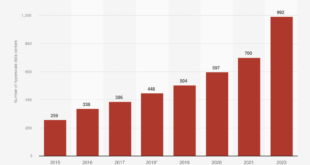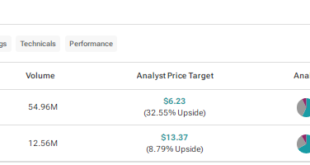The telecom industry is full of great dividend payers that consistently raise their payouts year after year. But one of the newest dividend payers in the industry is making the case that it might be the best bet for long-term dividend investors.
T-Mobile (NASDAQ: TMUS) instituted a dividend last September. A year later, it announced its first-ever dividend increase — and it was a big one. Shareholders will receive $0.88 per share every quarter starting in December, a 35% bump from T-Mobile’s original dividend. What’s more, management is promising double-digit dividend growth for years to come.
Here’s why T-Mobile might be the best dividend stock of the bunch among the telecom giants.

All about cash flow
Since completing its merger with Sprint in 2020, T-Mobile has produced massive free cash flow growth for shareholders. Free cash flow grew from $3.2 billion that year to $13.6 billion last year. Over the next three years, management expects free cash flow to climb to between $18 billion and $19 billion.
For reference, T-Mobile’s biggest competitors, AT&T and Verizon, produced free cash flow of $16.8 billion and $18.7 billion, respectively, last year. The two expect to maintain similar levels of free cash flow this year.
T-Mobile has managed to grow its free cash flow to levels approaching its more established competitors’ with consistent execution exceeding its original guidance. For example, management delivered more than $8 billion in merger synergies since integrating Sprint, above its $7.5 billion target provided in 2021. It also completed the network integration a year earlier than planned.
T-Mobile’s spectrum portfolio ensured it could bid more strategically on FCC auctions for additional bands, which meant it didn’t have to pay exorbitant prices for new radio waves. As such, it could focus its capital investments on building out its 5G network, which remains well ahead of AT&T’s and Verizon’s in terms of coverage.
One area where T-Mobile hasn’t invested as much as AT&T and Verizon is fixed-line assets. It’s expressed interest in the area, and partnered with Metronet and Lumos to take advantage of their fiber assets. T-Mobile’s model of leasing most of its fixed-line assets keeps capital expenditures low, but comes with ongoing costs.
That said, T-Mobile has shown the strategy works well. Its wireless customer base has grown faster than the competition’s, and its home internet subscriber base is growing faster than that of its competitors combined. It’s now targeting 12 million home internet subscribers by 2027, primarily leveraging the added capacity of its 5G network. The result is strong conversion of service revenue to free cash flow.
T-Mobile plans to return most of that free cash flow to shareholders.
How much could the dividend keep growing?
At its investor day, management said it expects to generate $80 billion in “cumulative cash flexibility” between now and 2027. $50 billion of that is earmarked for T-Mobile’s capital return program, which consists primarily of share repurchases.
T-Mobile’s dividend remains a small part of its capital returns. Over the first year of its dividend, T-Mobile paid out about $3 billion total to shareholders in cash. Even with the big 35% raise, T-Mobile’s only going to pay out about $4 billion over the next year.
As T-Mobile uses much of its additional capacity to buy back shares, it increases its ability to raise its dividend in the future. With fewer shares to pay a dividend on, it has more cash per share to pay out.
Management said it’s targeting a mid-20% portion of free cash flow for its dividend. So, if free cash flow comes in around $18.5 billion in 2027, that’s a total dividend payment of about $4.6 billion. That would translate into about 10% dividend increases in each of the next two years as management aggressively reduces its share count.
Management also noted that there’s an additional $20 billion in the budget, which could be used for strategic investments or acquisitions. But if there’s any additional funds left, the shareholder return program is the likely beneficiary.
Importantly, there’s a lot of room for T-Mobile to increase the dividend as a percentage of free cash flow over time, since cash flow is very predictable in the industry. AT&T and Verizon paid out 48% and 59% of free cash flow in dividends last year, respectively.
T-Mobile’s stock is priced at a premium to AT&T and Verizon. Its enterprise value (EV)-to-EBITDA ratio of 12 is higher than both AT&T’s (6.8) and Verizon’s (8.8). But with strong EBITDA and free cash flow growth on the horizon, T-Mobile is worth the premium price. At the current share price, T-Mobile’s 1.7% yield might not look that appealing compared to the older telecom giants, but the potential for total returns from share repurchases and dividend growth over time is extremely attractive for patient investors.
Should you invest $1,000 in T-Mobile US right now?
Before you buy stock in T-Mobile US, consider this:
The Motley Fool Stock Advisor analyst team just identified what they believe are the 10 best stocks for investors to buy now… and T-Mobile US wasn’t one of them. The 10 stocks that made the cut could produce monster returns in the coming years.
Consider when Nvidia made this list on April 15, 2005… if you invested $1,000 at the time of our recommendation, you’d have $752,838!*
Stock Advisor provides investors with an easy-to-follow blueprint for success, including guidance on building a portfolio, regular updates from analysts, and two new stock picks each month. The Stock Advisor service has more than quadrupled the return of S&P 500 since 2002*.
*Stock Advisor returns as of September 30, 2024
Adam Levy has no position in any of the stocks mentioned. The Motley Fool recommends T-Mobile US and Verizon Communications. The Motley Fool has a disclosure policy.
This Telecom Giant Just Increased Its Dividend 35%, and It’s Promising Many More Double-Digit Raises to Come was originally published by The Motley Fool
Source link
 meganwoolsey Home
meganwoolsey Home



